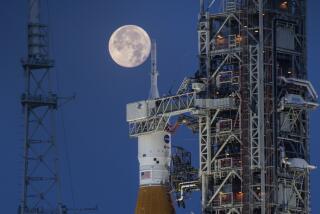Shuttle to Land 3 Hours Earlier Because of Winds
- Share via
HOUSTON — The five astronauts aboard the shuttle Atlantis prepared Sunday to return to a planet they now view with increased awareness of its fragility, planning to touch down today at Edwards Air Force Base at 9:33 a.m., three hours earlier than planned.
Concerns over potentially high midday winds at the Mojave Desert landing site caused flight directors here Saturday to plan to bring Atlantis down one orbit earlier, but by Sunday they had decided that even that might not be soon enough. So Atlantis is now set to land two orbits early in the expectation that the earlier the landing, the lighter the winds.
Maximum head-wind gusts are expected to be 23 m.p.h. at landing time, well under the 29-m.p.h. limit imposed by the National Aeronautics and Space Administration.
Nearly all astronauts who have spent a few days orbiting the Earth report that they were struck by the vulnerability of the planet as viewed from space, but the crew of Atlantis had an extraordinary opportunity to examine the Earth as a troubled planet. They spent five days looking for the hot spots.
After completing the primary objective of the mission, launching a $1.4-billion robotic spacecraft on a six-year journey to Jupiter, the astronauts spent much of their time filming areas of the Earth that are suffering from environmental degradation. The films will be incorporated in an IMAX movie called “The Blue Planet.”
“The world as we know it is a very fragile place,” Atlantis Commander Donald E. Williams, 47, said Sunday as the spacecraft sped over Central America. The shuttle’s cameras have focused on rain forests that are being cut down on a staggering scale in South America to open the land to agricultural uses.
Scientists believe that the elimination of those forests will worsen the growth of carbon dioxide in the atmosphere because plants take in carbon dioxide and release oxygen. An increase in the amount of carbon dioxide in the atmosphere is the reason many scientists now believe the planet faces a greenhouse effect that could raise temperatures globally with disastrous results.
The primary cause of the greenhouse effect is not the elimination of rain forests, although that is viewed as a contributing factor. The real villain, according to most scientists, is a human race that continues to burn fossil fuels, thereby pumping carbon dioxide into the atmosphere and releasing other airborne chemicals that are gnawing away at the layer of ozone that protects the Earth from harmful solar radiation.
Mission specialist Ellen S. Baker, 36, a physician-astronaut, was particularly struck by the vulnerability of the planet after running an experiment designed to study the depth of the ozone layer.
“You get an appreciation of how thin the protective layer is when you look at it from here,” she said from Atlantis on Sunday.
The astronauts had a vivid demonstration of just how important that layer is when they watched in awe as southern lights lit up the sky over the South Pole. The auroral activity, which also occurs over the North Pole, is caused by tiny particles blasted off the sun at 1 million m.p.h. that interact with particles in the Earth’s atmosphere.
The sun also bombards the Earth with ultraviolet radiation. The ozone layer absorbs the harmful radiation, and that is believed to be a crucial component of the planet’s ability to sustain life. The astronauts aboard the shuttle used an instrument to collect data on ultraviolet light that is being scattered by the ozone. Scientists hope that will help them draw a profile of the ozone layer.
At times, the images sent back by the crew of Atlantis were more down to Earth, including spectacular flashes of lightning dancing across the west coast of Africa and a super typhoon, Elsie, as it ripped across the Sea of Japan. Other shots included forest fires in Africa and the oil fields of West Texas.
“It’s just been gorgeous,” Baker said Sunday as the crew prepared for landing. “Our world is a beautiful place and we do need to take care of it.”
The other members of the crew are Franklin R. Chang-Diaz, 39, a plasma physicist; Shannon W. Lucid, 46, a biochemist, and Michael J. McCulley, 46, the pilot.
Williams, who piloted the Discovery on a 1985 mission, said from space Sunday that the re-entry should be something to behold.
“As the orbiter enters the atmosphere, it heats up (the air molecules outside the spacecraft) eventually to where it looks like you’re inside a fire looking out.
More to Read
Sign up for Essential California
The most important California stories and recommendations in your inbox every morning.
You may occasionally receive promotional content from the Los Angeles Times.













